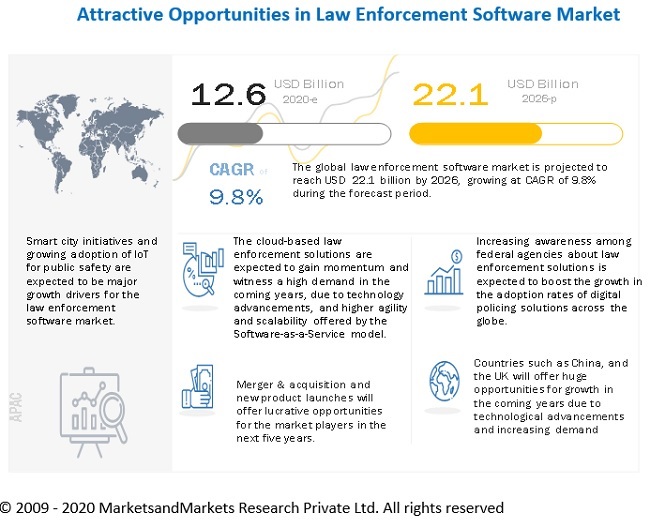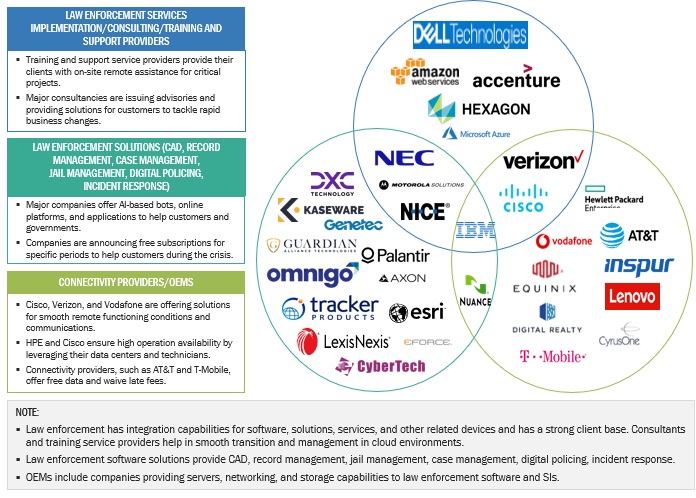< Key Hightlight >
The global law enforcement software market size is expected to grow from USD 12.6 billion in 2020 to USD 22.1 billion by 2026, at a Compound Annual Growth Rate (CAGR) of 9.8% during the forecast period. The law enforcement software market will continue to grow post-COVID-19 as more law enforcement software agencies across the globe plan to migrate its IT infrastructure to cloud, boost departmental operations, and improvise processes. While technology spending in APAC has increased, the setback due to the recent COVID-19 pandemic is imminent.

To know about the assumptions considered for the study, Request for Free Sample Report
COVID-19 Impact law enforcement software Market
Various government bodies and law enforcement agencies globally are working together to maintain public order to curb the community transmission of the COVID-19 virus. The Centers for Disease Control and Prevention (CDC) in the US and other agencies globally have made recommendations for law enforcement agencies to protect the public. Governments in various countries have responded to the global pandemic by restricting the public in high-traffic areas, launching community outreach initiatives, implementing nationwide lockdowns, limiting access to government facilities, and other preventive measures. The COVID-19 pandemic has exposed law enforcement agencies to difficulties related to communication, infrastructure management, enforcement of public health restrictions, and changes to crime and service patterns.
Law enforcement software Market Dynamics
Drivers: Increased focus on community-oriented policing
Community-oriented policing is a strategic move adopted by law enforcement agencies, and this enables them to work closely with the community and improve the members’ quality of life. Communities play a key role in defining their security and safety needs, and community-oriented policing encourages citizens and law enforcement officers to establish a healthy partnership and prevent future crime incidents. For the past few years, there is a rapid increase in the adoption of community policing methods laid by law enforcement organizations to increase the effectiveness of the police force in preventing and responding to crime incidents. Hence, this factor is expected to act as a driver for the adoption of law enforcement software. The increased focus on community-oriented policing allows law enforcement professionals to solve crimes and prosecute criminals at a faster pace.
Restraints: Government compliances and regulations
Law enforcement agencies globally are keenly focusing on intelligence and security. Intelligence provides law enforcement agencies an effective way of solving crimes. On the other hand, security ensures crucial data does not fall into the wrong hands. The surveillance carried out by law enforcement authorities helps gather massive information related to a crime or the criminal activities before their occurrence, in turn, helping with establishing the occurrence of the crime. Law enforcement software solution providers must adhere to government compliances and regulations, such as General Data Protection Regulation (GDPR) in Europe and Criminal Justice Information Services (CJIS) in the US to provide appropriate controls for protecting crucial information, as this software is used for managing personal information and helping law enforcers in the investigation, detection, or prosecution of criminal offenses.
With the introduction of GDPR in Europe, any public or private organization using CCTV to monitor public accessible areas must adhere to the regulatory requirements. For instance, the authorities monitoring on-premises video surveillance, access control, or Automatic Number Plate Recognition (ANPR) systems are subjected to EU GDPR compliance, which includes securing access to systems and servers that store the information. Under the terms of the EU GDPR, the use of encryption and automated privacy tools is a requisite. For instance, the faces of people must be blurred through video redaction unless there is a legitimate reason to reveal their identity. This can minimize the danger of having security cameras deployed in public spaces and safeguard the privacy of individuals.
Challenges: Lack of efficient storage and data management capacities
Public safety and law enforcement agencies are incorporating various digital solutions, such as high-quality video surveillance, body-worn cameras, and in-car cameras to provide reliable evidence against criminals. However, while body-worn cameras provide various public safety benefits, they also create public safety challenges such as data security. For instance, the US-based law enforcement agency, Seattle Police Department, generates more than 360 terabytes of data from dashboard cameras alone. The police department in Duluth (a city in Minnesota, US) was able to spend USD 5,000 on cameras but struggled to come up with USD 78,000 toward data storage fees for two years. As per the Motorola 2018 Law Enforcement Survey Report, approximately 85% of respondents wanted more multimedia capabilities to investigate criminal activities.
Opportunities: Integration of artificial intelligence and machine learning technologies
The integration of Artificial Intelligence (AI) technology makes law enforcement smarter by offering the ability to digitalize, formalize, optimize, and automate a wide variety of tasks currently performed by skilled human experts. With Machine Learning (ML), the law enforcement software continually evaluates data to predict the future and suggest data-driven improvements to enhance operational performance. Law enforcement worldwide is leveraging AI these days to run investigations and other operations with data-driven strategies derived through the data acquired through customer-faced applications. Hence, law enforcement agencies are expected to spend more on business intelligence and analytics in the coming years.

To know about the assumptions considered for the study, download the pdf brochure
Based on service, implementation service segment to be a larger contributor to the law enforcement software market growth during the forecast period
Implementation services help avoid the complexities involved in deploying law enforcement software solutions and integrating them with the agencies’ systems. They enable law enforcement organizations and agencies to adopt newer technologies for making society safe and secure. The process involves analyzing the agencies’ needs, understanding the operational functionalities of the existing systems, and integrating value-added features as per the specific requirements.
Based on deployment model, the on premises segment to be a larger contributor to the law enforcement software growth during the forecast period
In on-premises deployment, solutions are installed on the hardware located on the premises of the law enforcement agencies. When adopting the on-premises model, everything from implementation to running of the solution occurs within the agency’s physical infrastructure. The law enforcement personnel have physical access to critical case records and can manually control the configuration, management, and security of the computing infrastructure and data. Though on-premises solutions are not as cost-effective as cloud-based solutions, many law enforcement and public safety agencies are adopting this deployment model for security concerns as they deal with extremely critical data.
Asia Pacific (APAC) to grow at the highest CAGR during the forecast period
APAC economies are more susceptible to cyberattacks as there are several unsecured technology users in the region who are becoming prime targets for cybercriminals. In the last five years, APAC has experienced tremendous economic growth, political transformations, and social changes. Owing to the sophistication of cyber threats, countries such as Japan, China, and Singapore have launched new national cybersecurity policies. As APAC is an emerging economy, it is witnessing dynamic changes in the adoption and implementation of new technologies with the proper infrastructure. There is a huge potential in this region for the law enforcement software market, and software vendors can tap the opportunity to enter APAC. APAC countries such as India and China can become an important prospect for solution vendors due to their large population and the efforts of the local and central governments to reduce the response time in case of emergencies for the public safety departments. The major economies in APAC include Australia and New Zealand (ANZ), China, Japan, and the rest of APAC. These economies are technology-driven and offer major opportunities for law enforcement solution vendors.
The law enforcement software market is dominated by companies such as IBM (US), Accenture (Ireland), Motorola Solutions (US), Axon (US), NICE (Israel), Esri (US), Nuance Communications (US), Palantir Technologies (US), Hexagon (Sweden), Genetec (Canada), Omnigo (US), eForce (US), Cyrun (US), CAPERS Software (US), DXC Technology (US), Guardian Alliance Technologies (US), Column Case Management (US), Matrix Pointe Software (US), CyberTech (India), Lexipol (US), Tracker Products (US), LexisNexis Risk Solutions (US), CODY Systems (US), Presynct Technologies (US), and ALEN (US). These vendors have a large customer base and strong geographic footprint along with organized distribution channels, which helps them to increase revenues.
Scope of Report
Report Metric | Details |
Market size available for years | 2016-2026 |
Base year considered | 2020 |
Forecast period | 2020-2026 |
Forecast units | Value (USD Million) |
Segments covered | Component, Solutions, Services, Deployment Type, and Regions |
Regions covered | North America, Europe, APAC, MEA, and Latin America |
Companies covered | IBM (US), Accenture (Ireland), Motorola Solutions (US), Axon (US), NICE (Israel), Esri (US), Nuance Communications (US), Palantir Technologies (US), Hexagon (Sweden), Genetec (Canada), Omnigo (US), eForce (US), Cyrun (US), CAPERS Software (US), DXC Technology (US), Guardian Alliance Technologies (US), Column Case Management (US), Matrix Pointe Software (US), CyberTech (India), Lexipol (US), Tracker Products (US), LexisNexis Risk Solutions (US), CODY Systems (US) , Presynct Technologies (US) , and ALEN (US). |
This research report categorizes the law enforcement software market to forecast revenue and analyze trends in each of the following submarkets:
Based on the component:
Based on the solutions:
- Computer-aided dispatch
- Case Management
- Record Management
- Jail Management
- Incident Response
- Digital Policing
Based on the services:
- Implementation
- Consulting
- Training and Support
Based on the Deployment Type:
Based on regions:
- North America
- Europe
- UK
- Germany
- France
- Rest of Europe
- APAC
- China
- Japan
- Australia and New Zealand
- Rest of APAC
- MEA
- Saudi Arabia
- UAE
- South Africa
- Rest of MEA
- Latin America
- Brazil
- Mexico
- Rest of Latin America
Recent Developments
In January 2021, Motorola Solutions launched new Video-as-a service, the new offering is a combination of body-worn cameras, digital evidence management software, and cloud-based support. The main purpose of this offering is to offer better transparency to law enforcement agencies.




